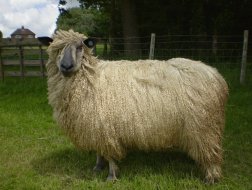Sheep Breeds
Pictures and brief information about each of the sheep breeds whose fibres we sell. All the fibres can be found on the natural wool tops page
Bergschaf
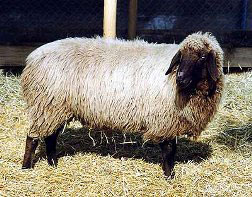
The Bergschaf is a cross breed of domestic sheep from the Tyrol area of Austria and Italy
Black Welsh Mountain
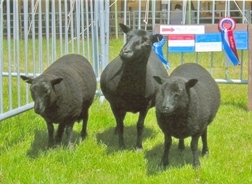
This coloured sheep is an ancient breed and was described in Welsh writings from the middle ages. They are relatively small black sheep with dense fleeces and no wool on their face or legs below their knees. The males have horns. Flocks are concentrated in Wales with smaller flocks throughout the UK.
Image provided by kind permission of the Black Welsh Mountain Sheep Breeders' Association.
Bluefaced Leicester
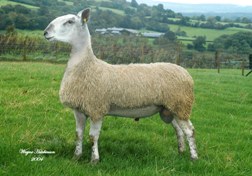
The Bluefaced Leicester originated near Hexham in Northumberland in the early part of the 1900s. It is a large sheep which takes its name from the characteristic blue skin on the head which shows through the white hair. Bluefaced Leicester rams are commonly bred with ewes from other breeds to produce commercial crossbred ewes known as mules. Flocks are located throughout the UK.
Image provided by kind permission of the Bluefaced Leicester Sheepbreeders Association.
Cheviot

There are two distinct breeds of Cheviot sheep: the South Country Cheviot originating from the Scottish borders, and the North Country Cheviot which was developed when 500 sheep were moved to North West Scotland over 200 years ago. Both are large rugged hill sheep.
Corriedale

The Corriedale was simultaneously evolved in both Australia and New Zealand about 1874 by cross breeding Merino and Lincoln sheep with the aim of creating a breed that would thrive in lower rainfall areas. Nowadays the breed is farmed in Australia, New Zealand, USA and South America.
Image supplied by kind permission of the Australian Corriedale Association. It shows a two year old ram from the Sweetfield stud in Victoria, Supreme Champion Corriedale Exhibit at the 2007 Australian Sheep and Wool Show.
Dorset Horn

They are now on the watchlist of the Rare Breeds Survival Trust.
Image kindly provided by the Dorset Horn and Poll Dorset Sheep Breeders' Association .
Gotland

Originally from the island of Gotland in Sweden, the Gotland breed has been developed ito produce a true multipurpose long wool sheep, yielding good flavoured close-grained meat, furskins and soft silky lustrous fleece which is beautiful for spinning or felting.
Image of Gotland Ram 'Zorro' kindly provided by the British Gotland Sheep Society.
Herdwick
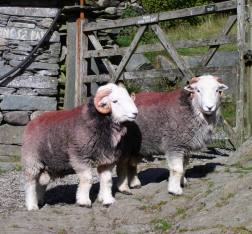
The name Herdwick comes from a Norse word meaning sheep pasture. The origin of the breed itself is unknown, but the most common theory is that the ancestors of Herdwick sheep were introduced by early Norse settlers. Herdwick are very hardy sheep which can survive on the high fells. Flocks today are still concentrated in the Lake District.
Image provided by Dorothy Wilkinson, Herdwick Sheep Breeders' Association.
The sheep have traditional red backs, which are now used for making the sheep more attractive when they are shown, but historically it is believed this was used to help the farmers locate their tups (rams) on the fells.
Hill Radnor
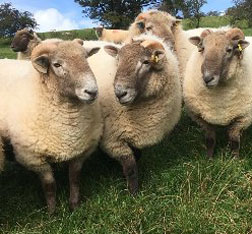
Rams are generally horned but can be naturally polled whilst ewes are always polled. The breed has a grey to grey tan head and legs which are totally free from wool. The muzzle tends to be lighter, almost off-white in colour and usually lightens with age. This unusual colouring sets it apart from most other British breeds.
Image by kind permission of Hill Radnor Flock Book Society.
Icelandic
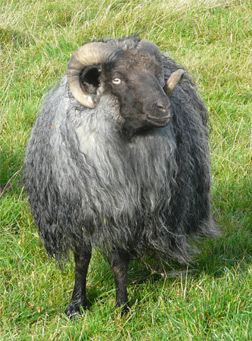
Icelandic sheep are a primitive breed which are hardy, intelligent, long-lived, alert and very fast on their feet. The fleece consists of a dual coat of very fine underwool (thel) and a long lustrous hair-like outer coat (tog), and is found in all the natural colours.
Image kindly provided by the British Icelandic Sheep Breeders Group.
Jacob
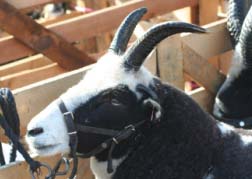
The Jacob sheep takes its name from the story told in the Old Testament Book of Genesis of how Jacob became a selective breeder of pied sheep, but are probably of Norse origin. They are mainly white with black patches and both sexes have large horns - either two or four. There are Jacob flocks throughout the UK.
Manx Loaghtan

The Manx Loaghtan is a small primitive brown sheep, one of the rare breeds of sheep on the watch list of the Rare Breeds Survival Trust. The breed originates from the prehistoric short-tailed breeds of sheep found in isolated parts of North West Europe where they survived because they were not replaced by more developed breeds. The Loaghtan is a multi-horned breed, with two or four horns in both ewes and rams.
Thanks to the Manx Loaghtan Sheep Breeders' Group for the picture.
Masham
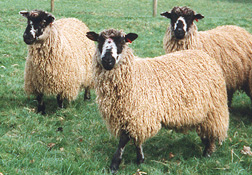
Masham sheep (pronounced Mass-am) are medium sized and hornless, and have been bred for over a century in the Northern Counties of England.They have a distinctive black and white face and legs and a woolly forelock.
The Masham is renowned for its hardiness and longevity, strong mothering instincts and high prolificacy. This is the result of parentage – a cross between a Teeswater ram with a Dalesbred or Swaledale ewe.The lustrous fleece is in demand for speciality uses including the fashion industry and upholstery.
Merino

The Merino is the most economically influential breed of sheep in the world, prized for its wool. Originally bred in Spain they are now located all over the world with particular concentrations in Australia, S.Africa and USA.
Norwegian

There are a variety of sheep breeds in Norway. This image depicts what is believed to be a spælsau sheep.
Romney

Romney sheep have been kept on Romney Marsh in Kent since the 13th Century and are probably the most numerous breed in the world. They are large sheep with broad faces and produce a heavy fleece with a slight lustre..
Image by kind permission of the Romney Sheep Breeders' Association.
Shetland

Shetland sheep are an ancient breed, said to have been brought to the Shetland Islands by Vikings in the 8th Century. Shetland are small sheep which may have fleece in a variety of different colours.
Image of Heather and Flora provided by kind permission of the Shetland Sheep Society.
Southdown

The Southdown is one of the oldest British sheep breed, dating from before the 17th century. Suffolk, Hampshire Down and Charollais breeds were originally derived from Southdowns. The UK Southdown population declined during the 1930s when the price of wool fell, and in the Second World War when many sheep farms in the South Downs were requisitioned for military purposes. They are now popular because the lambs grow quickly and are found throughout the UK and in France, Australia, New Zealand and the USA.
Image kindly provided by Southdown Sheep Society/Gareth Lloyd Hughes.
Suffolk

The Suffolk is one of our oldest, native British breeds and has been in existence since the late 1700s, when it evolved from the mating of Norfolk Horn ewes with Southdown rams. It has distinctive all-black head and ears, with the ears at right angles to the head.
Suffolk sheep are found throughout the UK and are also farmed in the Netherlands, USA, Australia and New Zealand.
Swaledale
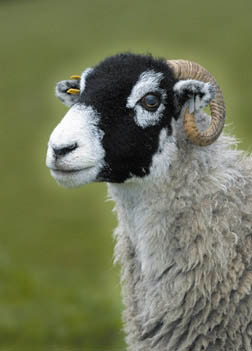
Swaledales are our "local" breed and are common throughout northern England. They probably originated from the genetic group of horned sheep. They are a bold, hardy sheep well suited to the hardships of exposed and high lying ground.
The ewes have proved to be most excellent lamb rearers, with ideal mothering abilities in all conditions. The Swaledale can now be found in both the hills and lowlands of Britain, producing both pure bred and the well known North of England Mule (a Blue Faced Leicester cross).
Image provided by kind permission of the Swaledale Sheep Breeders Association.
Teeswater

Teeswater sheep, indigenous as their name implies to Teesdale in County Durham, have been bred by farmers in that area for almost two hundred years.They are now on the watchlist of by the Rare Breeds Survival Trust.
Image by kind permission of Andrew Fisher.
Teeswater Sheep Breeders Association
White Welsh Mountain
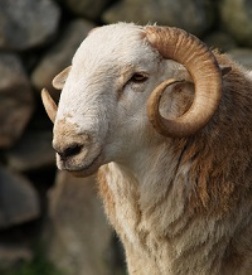
A very hardy breed . The wool contains kemp and is usually used for rugs.
Welsh Sheep Breeders Association
Wensleydale
The breed originated in North Yorkshire early in the 19th Century from a cross between a long since extinct local longwool breed from the region of the River Tees and an outstanding Dishley Leicester ram named "Bluecap". The fleece of this coloured sheep is widely agreed to be the finest and most valuable lustre longwool in the world. They are now on the watchlist of the Rare Breeds Survival Trust.
Image provided by kind permission of Sheila Leech, Wensleydale Longwool Sheep Breeders' Association.
Whitefaced Woodland

The Whitefaced Woodland is one of the largest of British hill breeds with both ewes and rams having horns. They are now on the watchlist of the Rare Breeds Survival Trust.
Image courtesy of RBST/Whitefaced Woodland Sheep Society.











